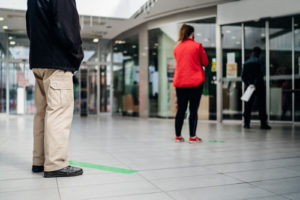A majority of college and university administrators participating in a recent survey said one of their top concerns is getting students to abide by social distancing recommendations.
Education firm EAB released findings from a recent survey of nearly 70 college and university leaders about their plans to promote social distancing on campus in order to prevent the spread of COVID-19 this fall.
Related content: Prioritizing students when planning for fall
Higher-ed administrators expressed widespread concern about whether students, especially undergraduates, would social distance. To encourage compliance, leaders said they plan to rely primarily on positive reinforcement. Many are still considering how they will discipline students who do not comply and how to ensure consequences are enforced equitably.
Administrators’ top three concerns all focused on student compliance, surpassing fears related to funding cost or time to prepare.
Nearly three-quarters (72 percent) of respondents said their greatest concern is getting students to follow social distancing guidelines in residence halls and in other on-campus housing.
While almost all institutions (93 percent) planned to use floor markings and signs to help students stay six feet apart, ensuring student compliance in on-campus common areas ranks as administrators’ second-biggest concern (57 percent).
The third most common concern (52 percent) was the extent to which students would follow safety measures while off campus.
“Enforcing social distancing in classrooms, libraries, and other public spaces won’t be easy, but schools know they will have little to no control over whether students adhere to safety guidelines when they go off campus or in private spaces in residence halls,” said Dr. Liz Rothenberg, EAB managing director.
A majority of respondents reported medium to high confidence in their ability to educate and promote social distancing among staff, faculty, and graduate students. In comparison, less than one-third (31 percent) expressed high confidence in their ability to promote social distancing among undergraduate students.
To increase awareness and educate students, most institutions intend to use positive reinforcement strategies, including depicting positive behaviors on social media (79 percent) and using student leaders and campus influencers to promote social distancing (75 percent). Furthermore, about two-thirds (67 percent) of respondents said they are planning to provide students with welcome kits that include safety materials such as face masks and educational information about physical-distancing protocols.
There is little consensus on what punitive measures schools will use to enforce new policies when students fail to comply. Some schools are not considering sanctions at all, while others are considering referring students for additional education and coaching and even banning students from campus for two weeks for repeated noncompliance. When it comes to carrying out these proposed penalties, the top concern was to ensure they are enforced equitably (52 percent).
“Preventing intentional and unintentional biases is top of mind for every institutional leader, including when it comes to making sure these new COVID-19 policies and procedures are enforced equally and fairly and that they won’t disproportionately affect students who are already facing greater challenges,” Rothenberg added.
Responses were collected in early June from senior student affairs leaders, including vice presidents of student affairs, deans of students, and chiefs of staff. Detailed survey insights can be found in a new post on EAB’s website, “What will social distancing look like for students at colleges and universities this fall?”
Material from a press release was used in this report.
- Report forecasts a ‘surge’ in GenAI adoption - April 26, 2024
- Where are microcredentials today–and where are they going? - April 22, 2024
- First-generation students are more likely to seriously consider leaving college - April 17, 2024

